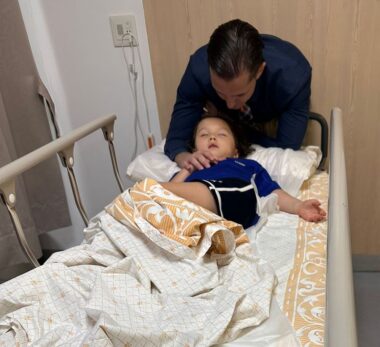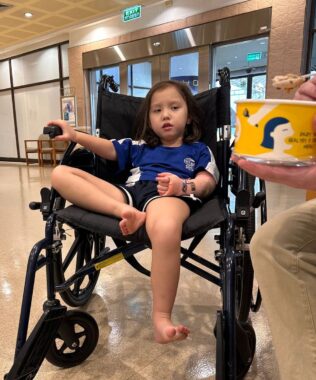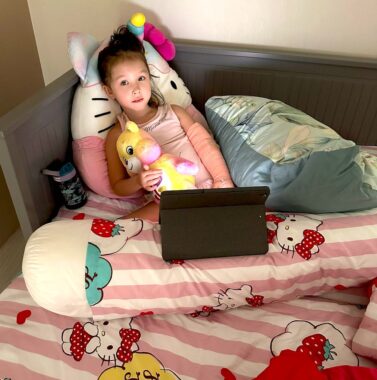A broken bone is a bump in the road, but it won’t stop our progress
This child with AADC deficiency is weathering a playground injury like a champ
Written by |

It took years of persuading our daughter, Rylae-Ann, to hop into the curved seat of the playground swing on her own and enjoy the freedom and weightlessness of swinging. When she turned 5 in April, we filmed and shared this significant achievement with family and friends after she finally took flight alone.
But this month, as she gained confidence, she attempted to jump off the swing during the apex of its arc. Unfortunately, our daughter’s balance isn’t as good as her confidence because Rylae-Ann has aromatic l-amino acid decarboxylase (AADC) deficiency. She took off sideways and landed hard on her arm. Now her arm is wrapped in a cast for the next month.
My wife and I were attempting to take steps back to no longer be a shadow hovering nearby to offer an unsolicited helping hand. We didn’t want to teach helplessness but rather build her independence.
Letting her swing by herself was one of the ways we worked to cultivate that independence. In hindsight, it was a bit too much, too soon. Ending up in a cast puts a halt on her therapy schedule. Once the cast comes off, keeping her arm immobile for weeks will be the new focus before we can continue her journey of success.
But all is not lost. My wife and I are both optimistic — we’re both glass-half-full kind of people. This unfortunate situation has created some positives.

Rylae-Ann lies in the ER exhausted from the pain and crying after breaking her arm on the playground. (Courtesy of Richard E. Poulin III)
Strengthening her dominant hand
Thankfully, the broken bone was not in her right arm. Her right hand can continue writing, exploring the world, and manipulating objects. She is now more reliant on it. There has been a noticeable improvement in dexterity and coordination. Obviously, this is not the ideal way to achieve this improvement, but we will not sit around and wait. We have to make the most of the situation. We continue to push her to write, grasp, and use her dominant hand to be independent.

Rylae-Ann leaves the emergency room with her arm in a cast after a playground accident earlier this month. (Courtesy of Richard E. Poulin III)
Initiation into childhood
I remember playing on a towering platform at the playground when I was 5. Truthfully, it was probably the height of my shoulders at the time. I also mindlessly launched myself off the top. I don’t know what I was thinking, but I remember landing on my arm and hearing a gut-wrenching crack.
This story is common for many children, and parents reading this probably have seen similar accidents. Breaking a bone or injuring oneself is almost a rite of passage.
A couple of kids in Rylae-Ann’s class completed this rite earlier in the year. So when she entered her class the next day with a cast, she was excited to show it off. She shared her story during circle time, and her friends showered her with attention.

Rylae-Ann relaxes in bed, nursing a broken arm, with her favorite stuffed animals and YouTube shows. (Courtesy of Richard E. Poulin III)
Learning to step back
This detour will not cause us to change our approach. After having gene therapy, Rylae-Ann continues to make memories and achieve developmental milestones like other children her age. The healing process is even happening at a typical rate with no complications. Rylae-Ann entered the hospital crying but allowed the doctors to examine her arm and the nurses to X-ray it with very little fuss.
All parents harbor fears of their children being hurt and hesitate to let them out of arm’s reach. Compared to the many hospitalizations that came before gene therapy, this mishap is much easier to manage. We will continue to push her forward while we learn to take a step back.
Note: AADC News is strictly a news and information website about the disease. It does not provide medical advice, diagnosis, or treatment. This content is not intended to be a substitute for professional medical advice, diagnosis, or treatment. Always seek the advice of your physician or other qualified health provider with any questions you may have regarding a medical condition. Never disregard professional medical advice or delay in seeking it because of something you have read on this website. The opinions expressed in this column are not those of AADC News or its parent company, Bionews, and are intended to spark discussion about issues pertaining to aromatic l-amino acid decarboxylase deficiency.






Leave a comment
Fill in the required fields to post. Your email address will not be published.